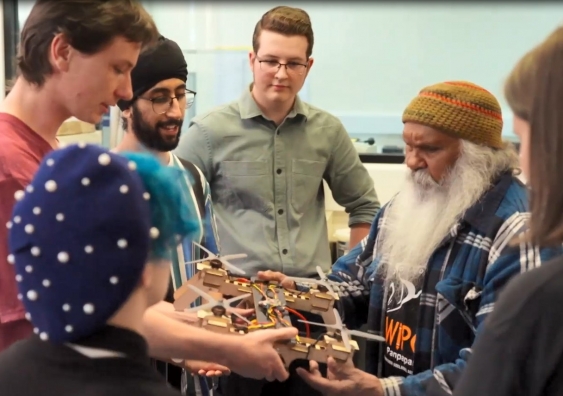University Of New South Wales experts bring David Unaipon’s ‘helicopter’ to life
In 1914 Aboriginal inventor David Unaipon proposed that two boomerangs working in tandem could lift a craft straight up in the air.
Nearly 110 years later, staff and students from UNSW Sydney have helped prove his theory was correct – and confirmed that boomerang technology, tens of thousands of years old, behaves like an aerofoil.
The project was filmed for TV show ‘The First Inventors’, co-commissioned by NITV and Network 10, which explores and celebrates the cultural knowledge of First Nations peoples. The four-part series takes a journey through time and Country with the next generation of knowledge holders to investigate our ancestors’ innovations.
Unaipon, a proud Ngarrindjeri man whose face now adorns the $50 note, had already patented a design for mechanical motion sheep shears in 1909. His machine converted curvilinear motion into a straight-line movement, and still forms the basis of the operation of modern mechanical shears today.
He soon turned his attention to potential vertical-lift flying machines, more than a decade before the first modern helicopter was flown, after making a careful analysis of the way a boomerang propels itself through the air.
“When I solved the flight of the boomerang…it seemed to me that I could do away with the preliminary run of the aeroplane, and make the machine rise direct from the ground,” he wrote at the time.
“I know that certain laws on which I work have not been tried before, but I am quite sure I shall be successful. I am aware of the opposing forces; but I know what to do to overcome them.
“The boomerang is shaped to rise in the air according to the velocity with which it is propelled, and so can an aeroplane.”
Unaipon was unable to get the backing he needed to turn his flying machine idea into a reality.
For ‘The First Inventors’ show, Ngarrindjeri Elder Uncle Major ‘Moogy’ Sumner – a direct descendant of Unaipon – visited UNSW to speak with students from the Faculty of Engineering and watch as they attempted to bring the century-old vision to life.
Dr Sonya A Brown, Senior Lecturer in Aerospace Design in the UNSW School of Mechanical and Manufacturing Engineering, led the project which used 3D-printed miniature boomerangs placed back-to-back to form the rotor blades for a small unmanned aerial vehicle, or drone.
“This was such a challenging and rewarding opportunity,” said Dr Brown.
“We were able to consider First Nations technology that is tens of thousands of years old in the boomerang, plus David Unaipon’s idea of using the boomerang for vertical flight from over 100 years ago and bring it all to life in a modern drone, demonstrating that David Unaipon’s idea was possible.”
In the show, which goes to air during NAIDOC Week, Uncle Moogy watches the drone take to the air and says: “It made me feel like Uncle David’s dream is coming true. It made me feel like my blood was rushing through my veins and feeling his spirit here.”
“I grew up knowing him. Watching this makes me feel like his dreams are coming to life. And he knows it because his spirit is here with us.”
As well as Dr Brown, PhD candidate Ahmed Mahgoub features in the program modelling the aerodynamic profile of a boomerang in flight.
The students involved in the build project were Clementine Hobill Cole, Akash Lakshman, Conrad Petrovic, Sophia Nicole Pablo, Natalie Chen, Nicole Harrington and Isabella Zdravkovic, aided by student leads Benjamin Tynan and Jasit Ghataure.
Both Nicole and Isabella have First Nations heritage and Isabella said: “This project tested my perseverance and encouraged me to come up with creative ideas to solve the problems we had.
“I also got to learn so much about how important the shape of the boomerang is and how it helps with the aerodynamics. It makes me proud as an Indigenous woman to work with this project.”
Dr Brown was also delighted to be able to play her part in helping the boomerang-powered drone to fly and bring such old knowledge right into the 21st century.
“To be honest, I think it was one of the most rewarding things I have done in my time at UNSW,” she says.
“We made it fly and it obviously meant so much to Uncle Moogy. He spent a whole day filming with us and was so generous in telling us his stories about the land from where David Unaipon came.
“The students worked really hard and Uncle Moogy’s stories made it so real. And, of course, that’s how a lot of Indigenous knowledge is passed on – through storytelling.
“So hearing the stories he shared was such a rewarding thing for myself and all the students. And then to see his joy when the drone was flying was an absolutely amazing experience.”

